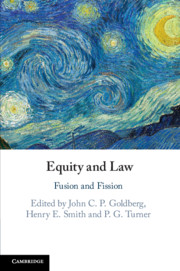Book contents
- Equity and Law
- Equity and Law
- Copyright page
- Contents
- Figures
- Table
- Contributors
- Acknowledgements
- Abbreviations
- Table of Cases
- Statutes
- 1 Fusion and Theories of Equity in Common Law Systems
- Part I Legal Systems and Legal Institutions
- 2 Equity
- 3 The Union of Law and Equity
- 4 What Did the Makers of the Judicature Acts Understand by ‘Fusion’?
- 5 At the Crossroads of Fusion
- 6 Fusion–Fission–Fusion
- 7 Fusion without Fission
- 8 Are Equity and Law in Scotland Fused, Separate or Intertwined?
- Part II Fusion and Fission in Doctrine and Practice
- Part III Functional, Analytical and Theoretical Views
- Index
6 - Fusion–Fission–Fusion
Pre-Judicature Equity Jurisdiction in New South Wales, 1824–1972
from Part I - Legal Systems and Legal Institutions
Published online by Cambridge University Press: 26 July 2019
- Equity and Law
- Equity and Law
- Copyright page
- Contents
- Figures
- Table
- Contributors
- Acknowledgements
- Abbreviations
- Table of Cases
- Statutes
- 1 Fusion and Theories of Equity in Common Law Systems
- Part I Legal Systems and Legal Institutions
- 2 Equity
- 3 The Union of Law and Equity
- 4 What Did the Makers of the Judicature Acts Understand by ‘Fusion’?
- 5 At the Crossroads of Fusion
- 6 Fusion–Fission–Fusion
- 7 Fusion without Fission
- 8 Are Equity and Law in Scotland Fused, Separate or Intertwined?
- Part II Fusion and Fission in Doctrine and Practice
- Part III Functional, Analytical and Theoretical Views
- Index
Summary
New South Wales was very late to receive the Judiacture Act system that effected fusion, and has been significant in discussions of fusion since for that reason. But did New South Wales need to administer law and equity separately in the first place? This chapter shows that when the Supreme Court was established, law and equity were administered without different courts or parts of the one court. There was already fusion, in that sense. But later, under colonial instruction, the fused court was differentiated when rules of court were made to replicate the procedures of the Court of Chancery at Westminster. In time, that differentiation became entrenched, and acquired some of the defects of the dual system abolished in England in 1875. Although the original set-up of the court did not require fusion – since it was already fused – by the 1960s fusion was needed, and came in 1972. The chapter shows the influence of local judicial figures and local events on experiences of fusion.
Keywords
- Type
- Chapter
- Information
- Equity and LawFusion and Fission, pp. 118 - 143Publisher: Cambridge University PressPrint publication year: 2019

